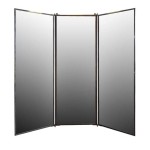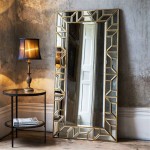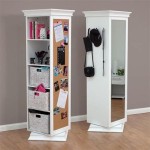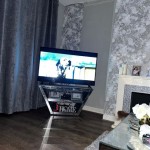Make Your Own LED Bathroom Mirror: A Comprehensive Guide
LED bathroom mirrors have become increasingly popular, offering a blend of functionality and aesthetic appeal. Pre-fabricated options are readily available, but creating your own LED bathroom mirror provides the flexibility to customize the size, design, and lighting to perfectly suit individual needs and preferences. This article provides a step-by-step guide on how to construct a custom LED bathroom mirror, detailing the necessary materials, tools, and techniques.
The process encompasses several key stages: planning and design, material acquisition, cutting and preparation, LED installation, mirror assembly, and final wiring and testing. Each stage requires careful attention to detail to ensure a safe and aesthetically pleasing result.
Planning and Design: Defining Your Mirror Specifications
The initial stage involves meticulous planning and design. This begins with determining the desired size and shape of the mirror. Measure the available space in the bathroom and consider the overall aesthetic of the room. A rectangular or square mirror is the most common choice, but other shapes, such as oval or circular, can add a unique touch. Account for any existing fixtures or design elements that may influence the dimensions.
Next, decide on the type of LED lighting desired. Options include backlighting, edge lighting, or a combination of both. Backlighting involves placing the LEDs behind the mirror, creating a soft, diffused glow. Edge lighting positions the LEDs around the perimeter of the mirror, producing a more direct and focused light. The choice depends on the desired illumination level and aesthetic effect. Consider the color temperature of the LEDs. Warm white provides a softer, more inviting light, while cool white offers a brighter, more modern feel. The color rendering index (CRI) indicates how accurately the LEDs render colors. A higher CRI is generally preferred, as it provides more natural and realistic lighting.
Detailed drawings are essential for accurate cutting and assembly. Include all dimensions, LED placement, wiring diagrams, and mounting details. This visual representation will serve as a guide throughout the construction process.
Consider the control mechanism for the LEDs. Options include a simple on/off switch, a dimmer switch, or a touch sensor. A dimmer switch allows for adjusting the brightness of the LEDs, while a touch sensor provides a sleek and modern interface. The chosen control mechanism should be integrated into the design plan.
Finally, plan the mounting method. The mirror can be hung on the wall using standard mirror clips, a French cleat system, or by attaching it to a pre-existing frame. Ensure the mounting hardware is appropriate for the weight of the mirror and the type of wall it will be attached to.
Material Acquisition: Selecting the Right Components
Once the design is finalized, gather the necessary materials. These include a sheet of mirror glass, LED strip lights, a power supply, wiring, a backing board, and mounting hardware. The quality of the materials will directly impact the longevity and performance of the final product.
The mirror glass should be of high quality, free from defects and scratches. Opt for a thickness of at least 1/4 inch (6mm) for added durability. If cutting the glass yourself, ensure you have the proper tools and expertise. Alternatively, have the glass cut to size by a professional glass shop.
LED strip lights come in various types, including single-color, color-changing (RGB), and addressable. Choose LED strips with a sufficient number of LEDs per meter to provide adequate illumination. The voltage of the LED strips must match the output voltage of the power supply. Look for LED strips with a waterproof rating if the mirror will be exposed to moisture. The LED strips should have an adhesive backing for easy attachment to the frame.
The power supply converts AC power to the DC voltage required by the LED strips. Select a power supply with sufficient wattage to power all the LEDs. Choose a power supply that is appropriately sized for the amount of LED strips you are installing. It is advisable to choose a power supply with a higher wattage rating than is needed to account for future expansion. Consider the power input of the LEDs and the output wattage of the power supply. A power supply with a higher wattage is preferable.
Wiring should be of an appropriate gauge to handle the current drawn by the LEDs. Use insulated stranded wire for safety and flexibility. Follow all local electrical codes when selecting and installing wiring.
The backing board provides structural support for the mirror and LED strips. MDF (medium-density fiberboard) or plywood are common choices. Ensure the backing board is dimensionally stable and resistant to moisture. The backing board should be slightly smaller than the mirror to allow for proper edge lighting, if applicable.
Mounting hardware should be appropriate for the weight of the mirror and the type of wall it will be attached to. Mirror clips, French cleats, or other suitable hardware can be used. Ensure the hardware is securely fastened to the wall studs or other structural elements.
Cutting and Preparation: Assembling the Frame and Preparing the Mirror
This stage involves precisely cutting the backing board to size, preparing the mirror surface, and creating any necessary cutouts for wiring or switches.
Using a saw, cut the backing board to the exact dimensions specified in the design plan. Ensure the edges are smooth and square. Sand any rough edges to prevent splinters. If edge lighting is desired, the backing board should be slightly smaller than the mirror to create a gap for the light to shine through.
Clean the back of the mirror thoroughly with glass cleaner to remove any dirt or debris. This will ensure proper adhesion of the LED strips and the backing board. Use a lint-free cloth to avoid leaving streaks or residue.
Determine the placement of the LED strips on the backing board. Use a pencil to mark the locations. If backlighting is desired, the LED strips can be arranged in a grid pattern or along the perimeter of the backing board. If edge lighting is desired, the LED strips should be positioned along the edges of the backing board, facing the mirror.
Drill any necessary holes in the backing board for wiring or switches. Ensure the holes are large enough to accommodate the wires or switches without damaging them. Use a drill bit that is appropriate for the material of the backing board.
Apply double-sided tape or adhesive to the back of the LED strips. This will help to secure them to the backing board. Ensure the adhesive is strong enough to hold the LED strips in place over time.
Attach the LED strips to the backing board, carefully aligning them with the marked locations. Press firmly to ensure good adhesion. Be sure to not bend or crease the LED strip lights during this stage to prevent damage.
Connect the LED strips to the power supply using appropriate wiring connectors. Ensure the polarity is correct (positive to positive and negative to negative). Use wire strippers to remove the insulation from the ends of the wires. Twist the wires together and secure them with wire connectors or solder them together for a more secure connection.
Test the LED strips to ensure they are working properly. Connect the power supply to a power outlet and turn on the switch. If the LED strips do not light up, check the wiring connections and the power supply voltage. If necessary, adjust the brightness of the LED strips using a dimmer switch.
LED Installation, Mirror Assembly and Final Wiring
The final stage involves attaching the mirror to the backing board, completing the wiring connections, and mounting the mirror on the wall.
Apply a continuous bead of mirror adhesive to the back of the mirror. This adhesive is specifically designed for attaching mirrors to various surfaces. Avoid using standard construction adhesive, as it can damage the mirror's reflective coating. Carefully position the mirror onto the backing board, aligning it with the edges. Press firmly to ensure good adhesion. Use clamps or weights to hold the mirror in place while the adhesive cures. Allow the adhesive to cure completely according to the manufacturer's instructions, typically 24-48 hours.
Once the adhesive has cured, remove the clamps or weights. Inspect the mirror for any gaps or imperfections. If necessary, apply additional adhesive or sealant to fill any gaps. Connect the wiring for the switch or dimmer control. Follow the wiring diagram carefully to ensure proper connections. Use wire connectors or solder to secure the connections.
Test the LED lighting to ensure everything is working correctly. Turn on the switch and adjust the brightness of the LEDs. Check for any flickering or other anomalies. Install the mounting hardware on the back of the backing board. Use screws or bolts that are appropriate for the weight of the mirror. Ensure the mounting hardware is securely attached to the backing board.
Mount the mirror on the wall, using the appropriate mounting hardware. Ensure the mirror is level and securely attached to the wall. Connect the power supply to a power outlet and turn on the switch.

Customized Led Mirrors For Your Home And Bathroom Inyouths

How To Diy Vanity Mirror With Led Strip Lights

Diy Light Up Vanity Mirrors You Can Make Ohmeohmy Blog

How To Make Your Very Own Led Vanity Mirrorbroke And Chic

How Lighted Mirrors Are Made Where You Can Use Them

Led Mirror Halo Bathroom Lighted Clearlight Designs

Bespoke Bathroom Mirrors

Custom Led Mirrors Miami Cm Glass Llc

Lighted Mirrors Creative Mirror Shower

Factory Custom Smart Touch Design Sensor Lighted Wall Mount Led Bathroom Mirror China Europe Fashion Hangzhou Manufacture Made In Com








